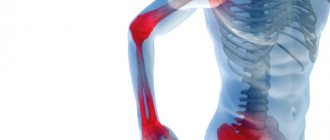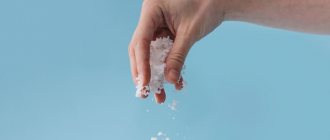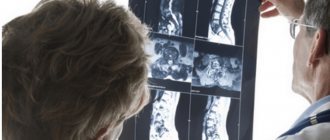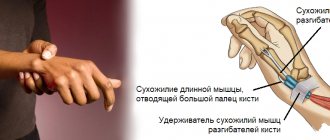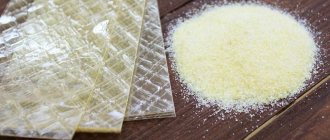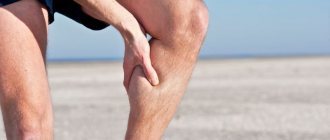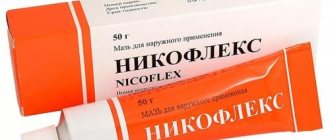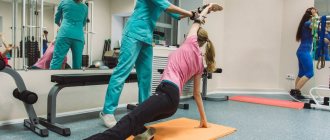Unpleasant sensations in the neck area are a frequent companion of modern man. Complaints about this problem increased sharply in the second half of the 20th century. This is explained by the emergence and spread of new “sedentary” professions, as well as a general decrease in physical activity of the population. A sedentary lifestyle and prolonged stay in an uncomfortable position can lead to inflammation or stretching of the neck muscles, the formation of clamps and displacement of the vertebrae. Moreover, the neck suffers not only from lack of movement, but also from excessive stress on the shoulders, spine and arms.
Photo: istockphoto.com
It is a rare person who has not experienced aching or nagging pain in the neck, but most do not take this problem seriously. Meanwhile, muscle discomfort can indicate serious illness and cause complications. Therefore, such pain should not be ignored.
In order not to go to extremes, you need to regularly perform simple exercises that effectively relieve pain and tension, and also help muscles get rid of tension. We tell you how to do some of them correctly.
Exercising to decompress: 10 exercises you can do in the office
How to do stretching and strengthening exercises for your neck and shoulder muscles
You will need a chair. Sit on the edge, straighten your back, lower and straighten your shoulders. Do each exercise for 10–15 seconds.
Turns and tilts
Turn your head to the right so that your chin is in line with your shoulder. Hold and then repeat the movement in the other direction.
Return to the starting position, tilt your head and look at the floor. Move your chin to the right and then to the left - this will increase the tension in the neck muscles.
Take the starting position, and then stretch your arms forward as if you are trying to reach something. Feel the stretch between your shoulder blades.
Chin to chest
Bend your head strongly, as if you are trying to reach your chin to your chest. Feel the stretch in the back of your neck and down to your shoulder blades.
Tilt your head again, but now clasp your hands and place them on top of your head, increasing the pressure. You can rotate your chin slightly to the right and left to shift the tension.
Dropped Shoulder Stretch
Lower your chin down diagonally to the right, while simultaneously reaching your left hand towards the floor. Repeat on the other side.
Semicircle head
Lower your chin towards your right shoulder. Without raising your head, slowly move it to your left shoulder, as if drawing a semicircle with your chin on your chest. Repeat on the other side.
Do not throw your head back at the extreme points: this creates unnecessary stress on the cervical spine. Do the exercise smoothly.
Sliding back and forth
Move your chin forward as if it were sliding in one line, then retract it.
Shoulder movements
Move your shoulders forward and then move them back and raise your elbows. Feel the stretch in your pectoral muscles. After this, raise your shoulders up, as if trying to reach your ears, and then lower them down.
Elbow circles
Spread your elbows to the sides, place your palms on your shoulders. Rotate your arms, trying to increase the amplitude.
Arm stretching
Lower and slightly spread your arms, palms forward, so that they do not touch the body. Stretch your fingers towards the floor, feel the stretch in your shoulders and elbows.
Relax and turn your hands with your palms back. Pull them down again and then pull them back without releasing the tension.
Strengthening the lateral neck muscles
Place your palm over your right ear. Half-heartedly press your hand on your head, trying to tilt it towards the opposite shoulder. Tighten your neck muscles, resist the pressure and keep your head upright. Repeat the same on the left.
Strengthening the front of the neck
Clasp your hands and place them on your forehead. Apply gentle pressure while trying to move your head back. Resisting the pressure, keep your neck straight.
Strengthening the back of the neck
Clasp your hands, place them on the back of your head and apply light pressure. Resisting the pressure, keep your neck straight.
Hands down with a towel
Take the towel by the ends, pull it tight and move your straight arms behind your head. Bend your elbows and try to lower them. The lower your elbows are, the better the muscles will stretch.
Transferring hands behind head
Take the towel by the ends, pull it taut and move your arms straight up. Bring your upper body forward and move your straight arms with the towel further behind your head.
Physiotherapeutic treatment
Physiotherapy for neck pain is a key step in relieving and treating pain. It is a necessary component in the prevention of complications, tissue restoration, and inflammation relief. The treatment regimen can use either one technique or several at once to enhance the therapeutic effect.
The use of physiotherapy enhances the effect of almost any medicinal substance, can help shorten the treatment time for acute diseases, reduce the duration of periods of exacerbation of chronic diseases and increase periods of remission.
Physiotherapeutic treatment for neck pain is aimed at relieving (relieving) pain, improving blood circulation and microcirculation in the affected segment, providing anti-inflammatory and anti-edematous effects, eliminating metabolic and dystrophic disorders, and reducing movement disorders.
Physical treatment methods can be used at the stages of inpatient and outpatient treatment.
In the acute period: after 2-3 days (as the severity of the process subsides), laser therapy, pulsed currents (SMT, DDT, interference currents), magnetic therapy, ultraviolet irradiation of the segmental zone, darsonvalization of the cervical-neck zone of the spine and the occipital region of the head, electrophoresis with substances with local anesthetic, ganglion-blocking effects on pain areas, acupuncture, superficial multi-needle application therapy Lyapko.
The use of Lyapko application therapy in the acute period is permitted, but the individual characteristics of the patient must be taken into account. If the pain intensifies, then you need to wait 2-3 days, if it becomes easier, then you can continue treatment with the Lyapko applicator.
In the remission stage: heat treatment is prescribed, including ozokerite and mud therapy for the cervical-collar area, balneotherapy (iodine-bromine, turpentine baths, laurel baths, bischofite baths), underwater shower-massage, therapeutic massage, manual therapy, and regular physical therapy exercises are required.
How to do yoga exercises
Follow the rules carefully and do not hold your breath. Maintain each pose for 30 seconds.
Half bend forward with emphasis on the wall (simplified uttanasana)
Stand straight, two steps away from the wall, facing it. Place your feet hip-width apart for comfort. From this position, bend at the hip and lean forward with a straight back to a 90° angle between your body and legs. Place your hands on the wall.
Try to straighten and stretch your spine as much as possible. Hold the pose for 20–30 seconds.
Warrior Pose II (Virabhadrasana)
Stand up straight, spread your legs wide, point your toes forward, raise your arms to the sides, connect and straighten your fingers.
Turn your right foot 90° to the right. Bend your right leg at the knee to a right angle or close to it, and move your left leg back. Distribute your weight between both legs.
Twist your pelvis, stretch your back, lower your shoulders. Try to open your pelvis and chest. Repeat the pose on both sides.
Twisting (Bharavajasana)
Sit on the floor, bend your right leg at the knee, point your shin outward and place your heel next to your pelvis. Bend your left leg at the knee, place your left foot on your right thigh.
Distribute your weight between your two sitting bones and lengthen your spine upward. Place your right hand on your left knee and turn your body and head to the left, grab your left toe with your left hand. Repeat on the other side.
What is neck pain
The neck performs many vital functions. It connects the head to the body. The cervical vertebrae and muscles are designed to provide the head with the greatest mobility. Between the vertebrae there are discs, next to which the nerves of the neck pass. The anatomical structure of the neck includes: muscles, arteries, veins, lymphatic vessels and nodes, thyroid gland, esophagus, larynx and trachea. Diseases of these organs and systems can cause pain in the neck and make it a rather vulnerable place.
Neck pain (cervicalgia) is pain of varying nature and intensity that occurs in the cervical region. Neck pain may be accompanied by dizziness, a feeling of numbness in the back of the head or arms, and swelling of the skin. The neck may hurt due to infectious and inflammatory diseases of this area, injuries and degenerative processes in the spine, after a long stay in a forced uncomfortable position.
Psychosomatics of neck pain
At the physiological level, the neck connects the head and body, and at the level of psychology of diseases, it is the place where the spiritual and material connect. Almost all experts in the field of psychosomatics agree that the neck is a symbol of flexibility of thinking, and pain in it is a person’s inability to look at the situation from a different angle. The neck symbolizes the flexibility of the mind and body, and painful sensations in it indicate a person’s stubbornness and reluctance to accept differing opinions; there is a serious internal conflict between his desires and common sense.
A person himself may not notice how he forbids himself to look where he wants or likes. The so-called “self-restraint”. Suppressed desire forms an energy block, which eventually turns into muscle tension.
How to get rid of neck pain and eliminate the psychosomatic cause.
- Give free rein to emotions. Any suppression of emotions leads to the formation of energy blocks in the body, which subsequently leads to physical pain. You need to be able to express all emotions: negative or positive, and do it consciously and on time.
- Develop mental flexibility. It is impossible to always be right; this is a sure sign of a lack of mental flexibility. You need to learn to accept other points of view and look at situations from different angles. Don’t forget to train your body, because everything is interconnected.
- Try to identify internal conflicts. It may be a job you don't like or an environment that is unpleasant to communicate with. You should never do something forcefully for a long time, as it will not lead to anything good. You need to take a break or try to change the situation and change something in your life.
- Reason objectively. A stiff neck can be a sign of narrow-mindedness and ignorance of real facts. Look at the situation from the perspective of a disinterested person.
- Do gymnastics regularly, including for the neck. With low physical activity, stagnant energy processes appear in the body.
- Listen to your body and emotions. Watch what you're doing when it starts to hurt.
Location of biologically active points for neck pain
A good result is achieved by influencing the acupuncture points of the cervical-collar region (Fig. 2). If the pain is localized in the anterior surface of the neck, it is better to use local points: IG16, IG17. With maximum pain, the best effect is exerted by distant points: GI4, P7.
For pain in the back of the neck: local: VB20, VB21, VB12, T15, V10, V11, TR15, TR16, IG15. distant: IG3, V60, VB38.
Local and distant active points on the painful side are treated with an inhibitory method (15-20 minutes), on the opposite side - with a tonic method (3-7 minutes).
Rice. 2 Acupuncture points used for neck pain
Application therapy Lyapko
Lyapko applicators in various modifications (plates, rollers, application belts, application tapes) are an original, powerful device with many health-improving therapeutic capabilities.
Their action is based on the principles of traditional Chinese medicine - superficial multi-needle acupuncture, as well as on the general physiological mechanisms of life.
Mechanisms of action of the applicator.
The high healing effect of Lyapko applicators is due to a combination of intense reactions:
- reflex-mechanical;
- galvano-electric;
- immunological.
Application therapy has a pronounced analgesic and antispasmodic effect. Improves blood circulation, lymph flow, microcirculation, reduces tissue swelling. Activates tissue mechanisms of immune defense, increases the level of its own opiate peptides and anti-stress hormones in the blood, reduces the level of sensitivity of pain receptors, has a positive psycho-emotional effect and, as a result, stimulates general human adaptation mechanisms. In contact with the skin, the applicator needles stimulate the release of a person’s internal medicines, engaging his “inner doctor” in the work.
It is important to note that local (local) improvement of blood circulation during application therapy occurs without additional stress on the heart, since the work of peripheral circulation increases and the heart rests at this time. This is very important for all categories of patients and, especially, with coronary heart disease, circulatory failure of 1-2 degrees, and elderly people.
For neck pain, many patients experience positive dynamics from Lyapko application therapy. It is combined with all types of medication and physiotherapeutic treatment. The ease of use of Lyapko application devices and their safety make it possible to carry out such procedures at home.
After removing the applicator at the site of its application, all pores are open for 10 minutes, so to improve the healing effect, you can apply ointments and creams that have an analgesic and anti-inflammatory effect.
